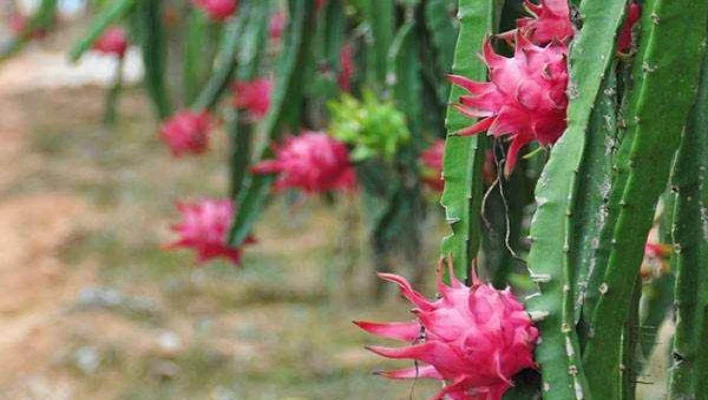Dragon fruit, also recognized as pitaya, is a tropical gem that sprouts on cactus-like plants. It boasts a vibrant pink or yellow skin, revealing a white or red flesh adorned with tiny black seeds. Now, when it comes to nurturing these exotic wonders, the secret lies in finding the perfect Dragon Fruit Fertilizer.
Packed with vitamin C, antioxidants, fiber, and minerals, dragon fruit is not only a feast for the taste buds but also a nutritional powerhouse. Let’s explore how the right Dragon Fruit Fertilizer can elevate your gardening game and help these cacti thrive.
If you want to grow your own dragon fruit plants, you need to provide them with the right conditions and care. One of the most important factors in choosing the best fertilizer for your dragon fruit plants. Fertilizer can help your plants grow faster, healthier, and produce more fruits.

Types Of Fertilizers For Dragon Fruit Plants
There are two main types of fertilizers for dragon fruit plants: organic and inorganic. Organic fertilizers are made from natural materials such as animal manure, compost, or seaweed. Inorganic fertilizers are made from synthetic chemicals such as nitrogen, phosphorus, or potassium.
| Type of Fertilizer | Advantages | Disadvantages |
|---|---|---|
| Organic | More environmentally friendly, more balanced, more slow-releasing | More expensive, more prone to leaching, more likely to cause nutrient imbalance |
| Inorganic | More cheap, more readily available, more specific | More polluting, more prone to leaching, more likely to cause nutrient toxicity |
Hence, dragon fruit enthusiasts typically favor organic fertilizers for their plants because they offer a more natural, balanced, and sustainable approach. Nevertheless, it’s worth noting that inorganic fertilizers can find utility in moderation, particularly when the soil lacks a specific nutrient.
Nutrient Requirements For Dragon Fruit Plants
Dragon fruit plants need three main nutrients for their growth and fruiting: nitrogen, phosphorus, and potassium. These nutrients are also known as N-P-K and are usually indicated by numbers on the fertilizer label. For example, a 10-10-10 fertilizer means that it contains 10% of each nutrient.
| Nutrient | Function | Example of Fertilizer |
|---|---|---|
| Nitrogen (N) | Foliage and stem growth | Animal manure, compost, urea |
| Phosphorus (P) | Root and flower development | Bone meal, rock phosphate, superphosphate |
| Potassium (K) | Fruit and seed development | Wood ash, seaweed, potassium sulfate |
| Calcium (Ca) | Cell wall and membrane structure | Egg shells, lime, gypsum |
| Magnesium (Mg) | Chlorophyll and enzyme production | Epsom salt, dolomite, magnesium sulfate |
| Iron (Fe) | Chlorophyll and enzyme production | Iron chelate, iron sulfate, blood meal |
| Zinc (Zn) | Enzyme production and plant hormone regulation | Zinc sulfate, zinc chelate, zinc oxide |
| Manganese (Mn) | Enzyme production and plant hormone regulation | Manganese sulfate, manganese chelate, manganese oxide |
In addition to these three main nutrients, dragon fruit plants also need some micronutrients, such as calcium, magnesium, iron, zinc, and manganese. These micronutrients are needed in smaller amounts, but they are still important for the plant’s growth and health.
How To Apply Fertilizer To Dragon Fruit Plants
The best time to apply fertilizer to dragon fruit plants is during the growing season, which is from spring to fall. During this period, the plants are actively growing and fruiting, and they need more nutrients to support their needs.
The best way to apply fertilizer to dragon fruit plants is by using the foliar method. This means spraying the fertilizer solution directly onto the plant’s leaves and stems. This way, the plants can absorb the nutrients faster and more efficiently, as they do not have to go through the soil.
Apply the solution to the plants using a spray bottle, a hose, or a sprinkler. Ensure even and thorough coverage on both the upper and lower surfaces of leaves and stems. Administer the fertilizer solution early in the morning or late in the evening when the sun is not too strong.

How Often And How Much To Fertilize Dragon Fruit Plants
The frequency and amount of fertilizing dragon fruit plants depend on several factors, such as the type of fertilizer, the soil condition, the plant’s age and size, and the climate.
However, a general rule of thumb is to fertilize the plants once a month during the growing season, and reduce or stop fertilizing during the dormant season, which is from winter to early spring.
The amount of fertilizer to use also varies depending on the type of fertilizer and the plant’s needs. However, a general rule of thumb is to use a balanced fertilizer, such as a 10-10-10 or a 20-20-20, and apply it at a rate of 1/4 to 1/2 teaspoon per gallon of water. You can adjust the amount according to the plant’s response and the soil test results.
You should always follow the instructions on the fertilizer label and avoid over-fertilizing or under-fertilizing the plants. Over-fertilizing can cause nutrient toxicity, which can damage or kill the plants. Under-fertilizing can cause nutrient deficiency, which can stunt or weaken the plants.
Conclusion
Fertilizing your dragon fruit plants is an important part of caring for them. Fertilizer can help your plants grow faster, healthier, and produce more fruits. However, you need to choose the right type of fertilizer, apply it correctly, and use it moderately.
Dragon fruit enthusiasts generally prefer organic fertilizers for their plants because they provide a more natural, balanced, and sustainable option. However, it’s important to note that in moderation, one can also use inorganic fertilizers, especially when the soil lacks a specific nutrient.
Dragon fruit plants need three main nutrients for their growth and fruiting: nitrogen, phosphorus, and potassium. They also need some micronutrients, such as calcium, magnesium, iron, zinc, and manganese.
Apply fertilizer to dragon fruit plants during the growing season (spring to fall). Use the foliar method by spraying the fertilizer solution directly on leaves and stems.
Fertilizing dragon fruit plants depends on factors like fertilizer type, soil condition, plant age, size, and climate. Typically, a rule of thumb is monthly fertilization during the growing season and a reduction or cessation during the dormant season, from winter to early spring.
Frequently Asked Questions (FAQ’s)
Organic fertilizers are ideal for dragon fruit, providing a natural and balanced nutrient boost.
Ensure ample sunlight, well-draining soil, and regular application of a balanced fertilizer during the growing season.
Opt for a foliar fertilizer rich in essential nutrients; spraying directly on leaves enhances absorption for robust growth.
Sturdy trellises or stakes offer excellent support, aiding in proper growth and preventing damage to the plant.
If your dragon fruit is sluggish in growth, consider factors like inadequate sunlight, poor drainage, or nutrient deficiencies. Ensure proper care, provide sufficient sunlight, use well-draining soil, and consider fertilizing appropriately to encourage healthy growth.
Dragon fruit grows best during the warm seasons of spring and summer. The combination of ample sunlight and higher temperatures promotes optimal growth and flowering, leading to a more fruitful harvest.

Meet Our Expert Agricultural Administrator
Welcome to agrigreenhands.com, your dedicated hub for all things related to agricultural farming. Leading the way in our commitment to sustainable and innovative practices is Jawad Hussain, our esteemed administrator with a profound background in agriculture….


